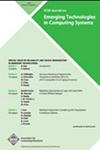Taming Molecular Field-Coupling for Nanocomputing Design
IF 2.6
4区 计算机科学
Q3 COMPUTER SCIENCE, HARDWARE & ARCHITECTURE
引用次数: 2
Abstract
Molecular Field-Coupling Nanocomputing (FCN) is one of the most promising technologies for overcoming Complementary Metal Oxide Semiconductor (CMOS) scaling issues. It encodes the information in the charge distribution of nanometric molecules and propagates it through local electrostatic intermolecular interaction. This technology promises very high speed at ambient temperatures with minimal power dissipation. The main research focus on molecular FCN is currently either on single-molecule low-level analysis or circuit design based on naïve assumptions. We aim to fill this gap, assessing the potential and feasibility of FCN. We present a bottom-up analysis and design framework that starts from the physical characterization of molecular and technological parameters and enables physical-aware FCN designs. The framework explicitly considers molecular physics, allowing the designer to tame the molecular interaction to ensure the computational capabilities of the final device. The framework permits studying possible physical effects that create cross-implications and correlations among physical and system-level layers considering possible behavior variability. We characterize and verify molecular propagation in increasingly structured layouts to design complex arithmetic circuits. The results highlight molecular FCN advantages, especially in area occupation, and provide valuable quantitative feedback to designers and technologists to support the assessment of molecular FCN and the realization of an eventual prototype.纳米计算设计中的驯服分子场耦合
分子场耦合纳米计算(FCN)是克服互补金属氧化物半导体(CMOS)缩放问题的最有前途的技术之一。它对纳米分子电荷分布中的信息进行编码,并通过局部静电分子间相互作用进行传播。这项技术承诺在环境温度下以最小的功耗实现非常高的速度。目前分子FCN的主要研究重点要么是单分子低水平分析,要么是基于naïve假设的电路设计。我们的目标是填补这一空白,评估FCN的潜力和可行性。我们提出了一个自下而上的分析和设计框架,从分子和技术参数的物理特性开始,使物理感知的FCN设计成为可能。该框架明确考虑了分子物理学,允许设计师控制分子相互作用,以确保最终设备的计算能力。考虑到可能的行为可变性,该框架允许研究在物理层和系统级层之间产生交叉含义和相关性的可能的物理效应。我们描述和验证分子传播在日益结构化的布局,以设计复杂的算术电路。结果突出了分子FCN的优势,特别是在面积占用方面,并为设计人员和技术人员提供了有价值的定量反馈,以支持分子FCN的评估和最终原型的实现。
本文章由计算机程序翻译,如有差异,请以英文原文为准。
求助全文
约1分钟内获得全文
求助全文
来源期刊
CiteScore
4.80
自引率
4.50%
发文量
86
审稿时长
3 months
期刊介绍:
The Journal of Emerging Technologies in Computing Systems invites submissions of original technical papers describing research and development in emerging technologies in computing systems. Major economic and technical challenges are expected to impede the continued scaling of semiconductor devices. This has resulted in the search for alternate mechanical, biological/biochemical, nanoscale electronic, asynchronous and quantum computing and sensor technologies. As the underlying nanotechnologies continue to evolve in the labs of chemists, physicists, and biologists, it has become imperative for computer scientists and engineers to translate the potential of the basic building blocks (analogous to the transistor) emerging from these labs into information systems. Their design will face multiple challenges ranging from the inherent (un)reliability due to the self-assembly nature of the fabrication processes for nanotechnologies, from the complexity due to the sheer volume of nanodevices that will have to be integrated for complex functionality, and from the need to integrate these new nanotechnologies with silicon devices in the same system.
The journal provides comprehensive coverage of innovative work in the specification, design analysis, simulation, verification, testing, and evaluation of computing systems constructed out of emerging technologies and advanced semiconductors

 求助内容:
求助内容: 应助结果提醒方式:
应助结果提醒方式:


